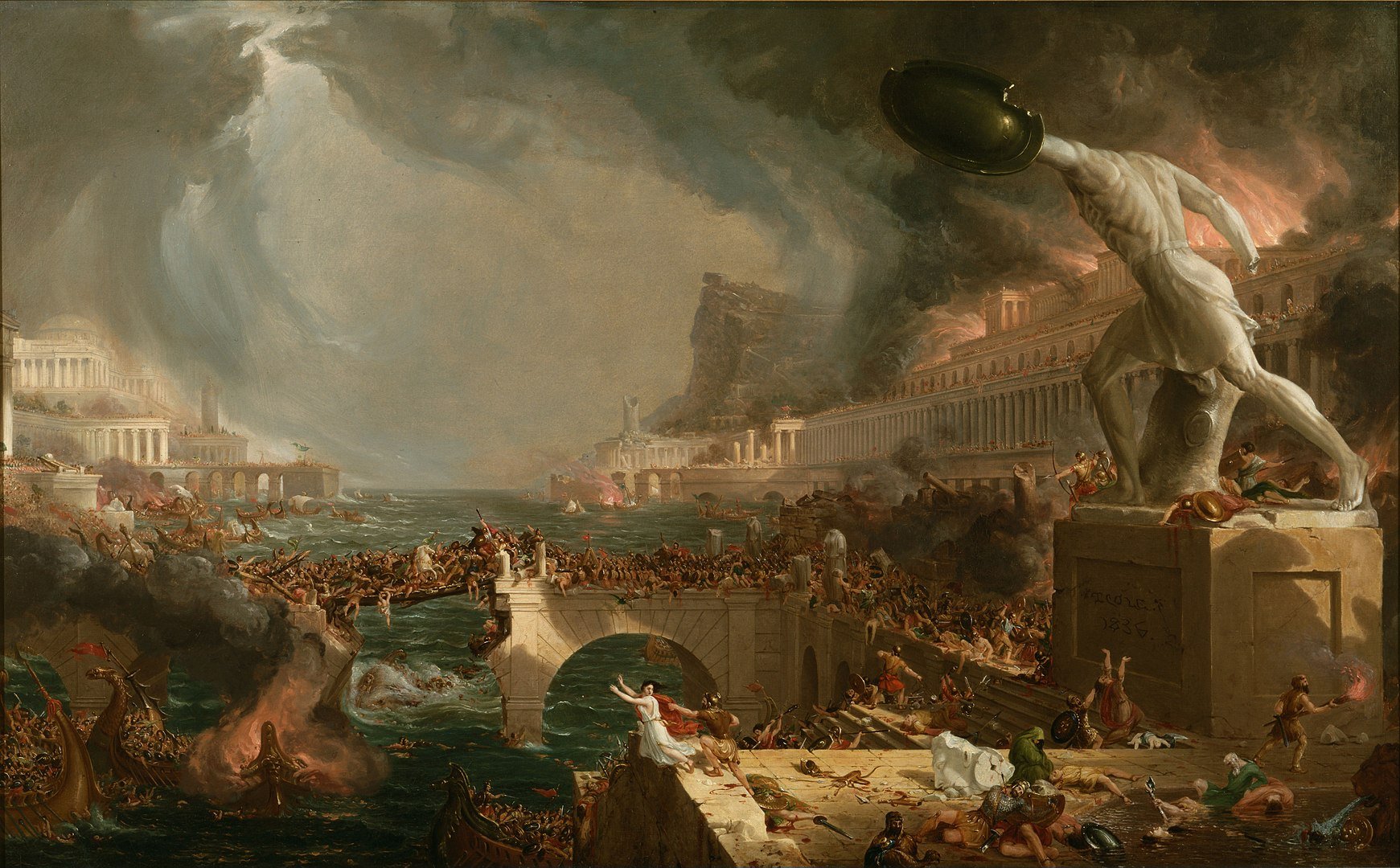The Long View 2009-01-01: Count Your Blessings

It might not be obvious, thirteen years later, but this was John J. Reilly’s deadpan satire of how 2009 could have been worse.
Count Your Blessings
For many people, the television images this morning of the continuing sack of the Green Zone brought a sense of closure, if not of satisfaction. In case anyone missed the point, American and European news channels took care to juxtapose images of the towers of smoke wafting from the government quarter during the “Shock and Awe” bombardment at the beginning of the war in 2003 with the eerily similar images from the Iraqi parliament and American embassy at its end.
Of course, this is the end for the United States, but not necessarily for the Iraqis (the images of looting and street fighting also have a certain resonance). Still, on this first day of the year, we can at least be sure that all American troops are out of Iraq, six months ahead of the withdrawal timetable promulgated by the Bush Administration in 2007. It is idle at this point to argue whether the offensive that the Administration was allegedly considering at the end of 2006 would have slowed down or even prevented the slide into chaos. The key point seems to have been the public announcement of the intention to exit without reference to facts on the ground. At that point, local actors who had been friendly to or tolerant of the American presence had to begin negotiating such terms as they could with those who were not. The result was the withdrawal of cooperation, not just with the United States, but with the provisional Iraqi state.
No doubt many commentators have a point when they note that the mere fact that television and Internet transmissions are still reaching us from several major Iraqi cities is evidence against the claim that Iraq has descended to Khmer Rouge levels of violence. Local authorities, who often seem at pain to mask their identities, are facilitating the work of select Arabic-language news networks and organizing the public decapitations of occupation collaborators for them to tape.
The Khmer Rouge analogy might more usefully be applied to the re-Talibanized areas of Afghanistan, a region that now includes the whole countryside and most major cities. However, the only “news” from the region is video exhortations from al-Qaeda and interviews from refugees who contrive to reach the areas of Pakistan where news bureaus can still function, so we cannot see what is happening. The dynamic of implosion in Afghanistan was not just similar to that in Iraq; it was the same process, sparked by the withdrawal timetable in Iraq, which made it clear to the strategically entrepreneurial leadership castes in Afghanistan that the West in general and the US in particular were unreliable and unprofitable patrons. The rapid changes of allegiance, you will recall, happened despite the redeployment to Afghanistan of a substantial fraction of the forces withdrawn from Iraq. Later this year, it seems clear, Afghanistan will produce images very like those from Vietnam in 1975, with local dependents and auxiliaries fighting to board helicopters from the roofs of residual enclaves in fallen cities.
These events are increasingly distant to most Americans, chiefly because the people started to withdraw psychologically from the war on terror even before the nation began to withdraw physically, but also because they are losing cable and Internet services. Among the many revelations of the obvious in 2008 was the realization of the fact that the predicate of cyberspace was the continued operation of the utilities that host and transmit it. The financial returns on managing information were already almost zero per unit of data; the freeze-up of the financial system made those returns negative. In bankruptcy, parts of the system continue to function through public subsidy, and public authorities are little inclined to offer the huge amount of cheap bandwidth to which the public had become accustomed. Those services are still available, of course, but at a huge premium. For an increasing number of users, the Internet again means email and the occasional graphic.
The collapse of the telecommunications industry was the most conspicuous but far from the most painful manifestation of the disintegration of the economy at every level. Again, arguing past debates is an idle exercise, but it does seem to be that the refusal of the US Congress to provide any subsidy money to the financial system, after the initial round of large private bailouts by the Treasury and the Federal Reserve, made a bad situation irremediable. A thoughtful psychotic in a mental ward is said to have remarked: “Do not let yourself go crazy. It is very, very hard to come back.” The key piece of insanity in this context was the acquiescence of the political class in the evaporation of the financial-paper markets, the system of short-term loans that made it possible even for solvent businesses to meet payrolls and buy inventory. Again, when it was clear that withdrawal was inevitable, the aquarium turned to fish soup, and could not easily be returned to its former state.
Curiously, this disaster for the populace was the result of an attempt to mollify populist opinion. The decision earlier in the year to grant a general amnesty to undocumented immigrants, balanced by promises of long-term improvements in border security, and other control measures, was unpopular when it was made. The result, however, was an unambiguous scandal that transcended partisan politics. There was an immediate police emergency in the border states. The immigration machinery stopped functioning, except for visas to advanced countries. The border melted. The system that had maintained it was not merely turned off, it was scrapped; and again, restoring it would be a matter of starting from scratch. Thus, when Congress began to hear from its constituents the kind of opposition it had ignored in the Spring in connection with immigration reform, it immediately determined that, this time, it would not take drastic, unpopular action.
Immediately after the November election, however, Congress did take action that was widely popular: the impeachment of President Bush and Vice President Cheney. Ordinarily, this would not have been possible, but president-elect Obama announced in his acceptance remarks that his respectable popular-vote majority constituted a “revolutionary mandate.” The current administration, he announced, was simply the formal president and his staff. He, in contrast, was the president of the people, and would begin to lead the nation immediately. He called on the president to begin negotiations for an early resignation or, failing that, to abstain from interference with the agenda he would immediately begin to enact with the progressive elements in Congress.
The president and vice president resisted these proposals; impeachment proceedings began the next day. Using email lists and other contact information compiled by ACORN during the presidential campaign, the Democratic Party machinery produced flash mobs outside the offices of congressmen and senators who opposed impeachment, or who merely tried to follow the methodical procedures developed during the Clinton Administration. The president was a virtual prisoner at Camp David; the Secret Service could not guarantee his safety at the White House. The vice president was criminally indicted and put under house arrest at the Naval Observatory.
Meanwhile, media opinion was almost wholly in favor of these steps. This was largely the result of the fact that almost the only major outlets that still functioned were able to do so with the emergency subsidies that Congress belatedly approved for enterprises deemed necessary to public order. In the media context, these were identified as the major daily newspapers and some cable channels other than Fox.
The incoming administration (which styles itself a “provisional government”) has not been able to control all the news, of course. There are simply too many channels for news, even with the system in a degraded state. Still, it does do a very effective job of controlling the prominence that certain stories are given. For instance, the conviction for hate crimes of Mark Steyn before Canadian federal and provincial human rights courts was the subject of laudatory editorials across the United States, and the occasion of new legislation in Congress to establish similar tribunals in the US. However, Steyn’s subsequent kidnapping and decapitation by Islamist fanatics, under circumstances that suggested collusion by the authorities, was reported by the New York Times on a Saturday on page ten, under the headline: SLANDERED YOUTHS ACT OUT.
Candide asked: “If this is the best of all possible worlds, then what must the others be like?” Well, now you know.
Copyright © 2009 by John J. Reilly



Comments ()